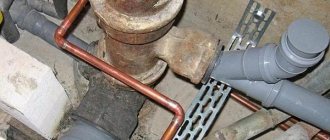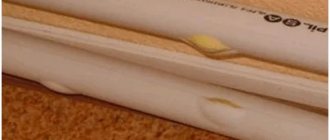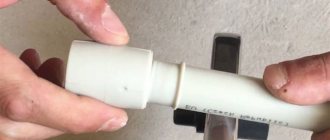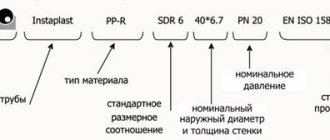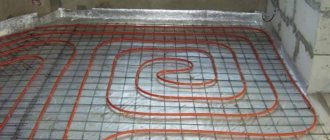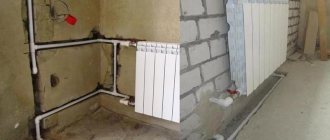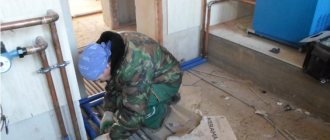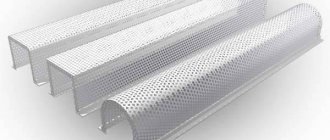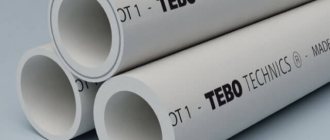Modern lines made of polypropylene pipes are of better quality and environmentally cleaner, unlike iron pipelines. The main reason for the superiority of polypropylene risers lies in the technical characteristics, installation technology and areas of application. And also in a wide range of diameters.
Basic benefits
Thanks to the variety of sections, wall thickness, and wide range of fittings, the products are easily combined with metal and plastic counterparts.
Main characteristics and scope of application of polypropylene pipes
Structures made of polypropylene risers often act as a distribution mechanism for the supply of liquids and gases.
Systems for supplying cold and hot water inside apartments or private cottages are installed from polypropylene pipes and fittings.
Polypropylene risers are the basis of water mains for technical needs in administrative buildings, residential premises, and industrial facilities. In most cases, heated floors are also made from these parts.
- They are indispensable when wiring central heating systems that use elements with different internal and external diameters.
- With their help, you can directly make a connection from the boiler to heating radiators in a private house.
- Reinforced polypropylene pipes are capable of functioning efficiently at temperatures up to +95℃ and pressures up to 25 atmospheres.
Considering such technical indicators, the products can confidently be used not only for heating systems with natural, but also with forced circulation.
Today, the agro-industrial complex, chemical, pharmaceutical, food industries cannot do without systems made of polypropylene of various calibers, ranging from 15-16 mm, and ending with parts of large sections: 300,400,500 mm.
Installation of heated floors
There are adapters of various types, with the help of which you can easily mate polypropylene risers of large or small sections with similar metal-plastic, steel, and plastic elements of highways.
Installation work using a soldering iron
The features of polypropylene make it possible to use parts made of this material in pipelines for supplying compressed air and chemically active substances.
In addition, risers are used for:
- installation of air conditioning systems;
- arrangement of drainage networks (corrugated elements);
- assembling irrigation structures.
Gradually and imperceptibly, the metal frames of greenhouses began to be replaced with polypropylene pipes.
Important! The advantage of the products: when creating arcs for a greenhouse or other structures, you do not need to use a special machine, since polypropylene can be easily bent with your own hands.
The choice of caliber of polypropylene parts is influenced by the dimensions of the future structure.
For these purposes, in the private sector, polypropylene pipes with an internal (or external) diameter from 15-20 to 25, 32 and 40 mm are most often used.
On an industrial scale, risers with an internal cross-section from 40 to 110 mm are used.
Important! It is necessary to choose thick-walled risers, since the greenhouse structure must be stable and reliable.
Today, metal pipes are often replaced with polypropylene ones. In recent years, you can find heated towel rails in the bathroom made of polypropylene parts. This phenomenon is very popular.
Therefore, many people assemble and connect a plastic heated towel rail with their own hands. For these purposes, parts with a caliber of 12 to 25 mm are used (corresponding approximately to the cross-sectional area of 20x20 mm square products). When creating a design, you should remember 3 important tips (for beginning craftsmen):
- Prepare all the necessary tools and materials:
- polypropylene products of appropriate calibers along with fasteners;
- couplings;
- Ball Valves;
- knife for cutting parts;
- A heating element of the required power (when choosing an electric or combined design option) with a half-inch external thread (thread pitch 1.814 millimeters).
- Do not start work if you have never held a tool for welding polypropylene parts with a cross-section of 15, 20 or more millimeters. The fact is that for high-quality docking, you must first read the instructions, undergo a little practice, and then work fully, while maintaining the appropriate temperature.
- Before starting work, it is necessary to make a schematic drawing indicating the system configuration and the linear dimensions of the structural elements.
Important! The fact that polypropylene belongs to the class of high-molecular compounds “Polyolefins” ensures the environmental friendliness of the created products of different sections.
1) Simple PPR; 2) PPR reinforced with aluminum
Installation of a heating system using polypropylene pipes
Installation of a heating system requires the correct choice of operation scheme. For example, the use of polypropylene pipes provides several options:
Installation diagram of hot water supply pipes.
- Gravity circulation of water in the system. In this case, there is no need to install a circulation pump, since the water movement will be independent. This option is suitable for rooms where there are frequent chances of problems with power outages, which will make it impossible to use the pump.
- Bottom heating system. This system has a radial distribution, which involves the presence of a pump used to increase water pressure, which requires a smaller diameter.
- It is possible to use one- and two-pipe systems with connection to the radiator using a side or bottom connection.
Return to contents
Polypropylene pipes - size table
One of the main characteristics that should be taken into account when choosing risers of specific sizes is the pressure of the transported medium. If it is not high, then install a line with a small cross-section. As the amount of moving water increases, it is necessary to increase the diameter of the pipes. Therefore, when purchasing a product, you need to pay attention to the marking (PN 10 or other similar designations) in order to imagine how resistant the products will be to possible pressures in the structure. The duration of the system’s operation depends on this.
Since the scope of application of polypropylene elements is quite wide, the range of products is also diverse.
For domestic purposes, the most popular are risers with a cross-section from 16 to 110 mm. Table 1. Dependence of linear dimensions on nominal pressure, mm
| Nominal pressure value | PN 10 | PN 20 | PN 30 | |||
| External gauge | Internal gauge | Wall thickness | Internal gauge | Wall thickness | Internal gauge | Wall thickness |
| 16 | — | — | 10,60 | 2,70 | — | — |
| 20 | 16,20 | 1,90 | 13,22 | 3,41 | 13,22 | 3,40 |
| 25 | 20,40 | 2,30 | 16,60 | 4,20 | 16,62 | 4,19 |
| 32 | 26,00 | 3,00 | 21,22 | 5,41 | 21,20 | 3,00 |
| 40 | 32,60 | 3,70 | 26,62 | 6,70 | 26,62 | 3,70 |
| 63 | 51,40 | 5,80 | 42,00 | 10,50 | 40,20 | 5,80 |
| 75 | 61,20 | 5,90 | 50,00 | 12,50 | 50,00 | 6,90 |
| 90 | 73,60 | 8,20 | 60,00 | 15,00 | — | — |
| 110 | 90,00 | 10,00 | 73,20 | 18,40 | — | — |
Important! The correct ratio of pipe cross-section and wall thickness is a guarantee of long-term and high-quality functioning of the structure.
What diameter of polypropylene pipes is used for heating
To select the correct size, the internal diameter of the pipes is calculated using the following formula:
where U is a value that is equal to the total water flow in the house, which will fall on a given water supply system,
L is the speed of water flow; for large diameter pipes it is considered to be 1.5-2 m/s, for small diameter pipes it is considered to be 0.7-1.2 m/s.
House heating system diagram.
Polypropylene heating materials are used in diameters of approximately 20-32 mm. To install heated floors, plastic ones with a diameter of 16 mm are most often used. It is important to assess all its complexity at the beginning of the work and select the necessary material. Taking into account various factors in the heating system, you need to correctly calculate the cross-section of the pipe. Many things are important here: medium temperature, flow speed, pipeline length, pipe diameter and hot water pressure.
It is believed that only a correctly calculated size of the required diameter of polypropylene heating pipes will help make the entire system reliable and efficient. In cases of incorrectly selected sizes, some shortcomings in the operation of the system are possible. For example, if the diameter is larger than required, then the pressure in the heating system will become lower than required, which will lead to disruptions in the circulation of water throughout all apartments in a large building. And only repair work, which involves replacing pipes with pipes of the correct size, can improve the operation of the system.
Return to contents
What influences the choice of diameter?
To correctly calculate the caliber of a product, you must use 2 criteria:
- permissible water flow rate;
- permissible pressure loss over a length of 1 m.
The permissible pressure loss is a purely economic criterion. Its essence: determining the balance between operating and capital costs. For example, the increase in the cost of a pipe is directly proportional to the increase in its caliber. And in order to pump water through a riser of a smaller cross-section, more energy costs are required for the operation of the pumping structure. Capital and operating costs can be depicted in the form of graphs. The point of their intersection will show the size of the optimal section of the part. But only specialists can do this.
Speed affects the permissible hygienic standards, which characterize the equivalent noise level in dB (recorded in SNIP). It depends on the cross section and can range from 0.83 to 1.52 m/s. In water mains, the speed limit is 3.0 m/s.
With this article read: What is a 32mm HDPE pipe used for, properties of low-pressure polyethylene collectors. Questions and answers (FAQ).
Types of PP pipes
Thanks to various designs, polypropylene risers can be:
- whole;
- reinforced.
The scope of application depends on the material used to make the product. The markings of the elements reflect their technical characteristics.
1) Fiberglass; 2) Aluminum; 3) Without reinforcement
Solid products include products with marking elements:
- PN10. They are distinguished by thin walls and low mass. They are used in cold water supply with ambient temperatures up to +20 °C (in some cases - up to +45 °C) at a pressure of 1 thousand kPa - 10 atmospheres.
- PN20. They are used in the construction of hot water pipelines (temperatures up to +80 °C). They function efficiently at pressures up to 20 atmospheres.
This type includes parts for the installation of sewer structures.
Differ:
- resistance to corrosion and temperature;
- smooth inner surface;
- ease of installation;
- long service life;
- breadth of assortment.
Reinforced parts include parts marked PN25. Used in hot water supply and heating systems. Due to the presence of a layer of fiber or glass fiber, aluminum foil, products are characterized by high strength and a low coefficient of thermal expansion. They function efficiently at ambient temperatures up to +95 °C at a pressure of no more than 25 atmospheres.
Materials and characteristics
Knowing the diameter is only half the battle, but when you come to the store, you will be faced with a variety of materials. Polypropylene pipes for heating comply with GOST R 52134–2003. They are made from three types of plastic, two of which can be used for hot water supply and heating systems:
- consisting of identical structural units. Their molecular bonds do not withstand heating and, accordingly, are not applicable for systems with high operating temperatures;
- consisting of different structural units. The heterogeneity of bonds between molecules makes them resistant to heat, while the material does not lose its natural elasticity;
- consisting of crystals. They have the most durable and temperature-resistant structure, but at the same time they lose elasticity.
The marking of polypropylene heating pipes indicates their outer diameter. Pay attention to this when you need to connect the outline of the apartment to the central riser. With an equal outer cross-section, metal and polypropylene pipes have different internal bores; for metal it is wider.
Be sure to choose reinforced products. Aluminum and fiberglass are used as reinforcement materials. It is better to give preference to the latter, since during installation there is no need to remove the reinforcement layer to the depth of the connection of the circuit with couplings and fittings. Aluminum reinforcement is carried out:
- monolithic layer;
- layer with multiple holes.
Reinforcement of polypropylene with perforated aluminum
Both aluminum and fiberglass reinforcement layers are sandwiched between two layers of plastic. Reinforcement is needed only to compensate for the increase in length of the contour when heated. There is no question of strengthening the product, since the plastic is already very durable. Non-reinforced products are not suitable because they have a too high coefficient of linear expansion, which is 0.15 mm/m. For comparison, for reinforced products it is 0.02 mm/m. Polypropylene pipes for heating have standard sizes. They are sold in lengths of four meters.
For clarity, let's carry out the calculation. Let's take one meter of circuit in which water heated to 80 degrees circulates. Multiply the temperature by the coefficient of linear expansion and get the following values:
- for reinforced products – extension by 1.6 mm;
- for non-reinforced products - extension by 12 mm.
The marking also indicates the nominal pressure. Denoted by the Latin letters PN. For example, a product marked PN16 can withstand 16 atmospheres, but this is not the maximum of its capabilities. It can withstand larger short-term increases. The nominal pressure is the indicator at which the service life of polypropylene pipes will be half a century. The calculation was performed using special programs, where the water temperature is set to 20 degrees. This is important; as the temperature increases, the service life will naturally be shorter, since when the plastic heats up, it changes its mechanical characteristics.
Section of polypropylene pipes:
For sewerage
Today, most sewage disposal lines are constructed from polypropylene risers. This is due to the many advantages of the products in comparison with analogues from other substances.
1) For internal sewerage; 2) For outdoor
In everyday life, sewer pipes with an outer cross-section of 32, 40, 50, 63, 75 mm are most often used for indoor distribution, and with a diameter of 100 (110 mm) for equipping waste risers. In multi-storey buildings, polypropylene products with a diameter of 110 mm or more are used for sewerage installations.
For water supply and heating
The laying of water pipes from polypropylene parts can be carried out either by air or in the soil. For these purposes in everyday life, the most popular parts are made of polypropylene with a caliber of 16-75 mm.
For internal wiring of water mains, parts with a cross-section from half an inch to an inch are suitable.
External wiring is mounted from elements with a caliber of 40, 50, 100 mm.
For internal distribution of cold water, elements with an external cross-section from 20.00 to 40.00 mm with a wall thickness of 1.90-10.00 mm are suitable.
Systems for transporting hot liquids are mounted from polypropylene products with a cross-section of 20.00-100.00 mm and a wall thickness of 2.80-15.10 mm.
To keep your house or apartment warm, you need to choose the right caliber of polypropylene risers for the heating system.
Important! It should be remembered that the coolant temperature reaches almost 100℃ at a pressure of several atmospheres. To ensure high-quality heating, you need to buy reinforced polypropylene parts.
The design of the heating system is such that it is necessary to use products of various calibers, starting from 16.00 and ending with 63.00, or even 75.00 mm. The wall thickness should be in the range of 3.40-10.50 mm. The choice of risers is also influenced by the cubic capacity of the room and the type of boiler.
1) Water supply; 2) Air duct made of polypropylene
For ventilation
Metal air ducts have been replaced by polypropylene ventilation. For its arrangement, polypropylene risers of large sections are used - starting from 100 and ending with 200, 300 mm and more
With this article read: 4 main types of PVC pipes, their classification and main characteristics. Answers to popular questions, podcast.
How to choose the right pipe diameter
In cases where heating is carried out in a private house or cottage, the pipes must be selected taking into account the fact that the diameter will not change only when there is a direct connection to the central heating system. In the case of an autonomous pipe system, pipes can be used of any size (different diameters and lengths), depending on the preferences of the owner of the house.
Related article: How to sew curtain tape: step-by-step instructions
When choosing the necessary workpieces, you need to take into account all the features, especially if we are talking about a natural heating system, where the ratio of the cross-section to the pump power will not be a primary feature. This fact is considered one of the advantages of this heating system.
Pipe installation diagram.
The disadvantage of such a system is the small radius of action and the high cost of large-sized elements used in this case.
To ensure the system operates efficiently, it is necessary to maintain a certain level of pressure in it, allowing the water moving inside to overcome all obstacles in its path. Resistance (obstacles) can be in the form of friction of water against the walls, outlet or tap and heating device. The most interesting thing is that the resistance and speed at which water will flow depend on the length and diameter of the pipeline pipes. With high water speed, a small cross-section and a long pipeline, the level of resistance along the water path increases.
Recommendations for choosing polypropylene pipes or how to choose the right size
Thanks to basic calculations, you can select polypropylene pipes of the desired size. To do this, it is necessary to have information about the speed of movement of the working medium and its consumption.
To simplify the calculations of the calibers of products required for arranging a heating system, it is best to use a special table.
Let's give an example of a typical calculation for a room with an area of 40 m². In this case, you should adhere to the following algorithm:
- We determine the thermal power required to uniformly heat the room. Considering that for every 10 m² of area with a room height of up to 3 meters, it is necessary to spend 1 kW of heat (if the walls are insulated). In our case it is 4 kW.
- We add a reserve of thermal power in the amount of one fifth of the obtained theoretical value (that is, plus another 800 W). In practice, this means that to fully provide heat to a room of a given cubic capacity, it is necessary to use 4.8 kW of thermal energy.
- If the room has windows, then you need to install heating radiators, the number of which should correspond to the number of window openings. We take into account that one heating battery emits about 1 kW of heat. Heating radiators are usually located under the windows.
- Using the table data, we find a power value of 4.82 kW, after which we fix the upper limit of the heat flow. We also record the optimal speed of water movement.
- To summarize: to heat a room of 40 m², you can use a heating system mounted from risers with an internal cross-section of 12 mm. The speed of movement of the working medium is 0.51 m/s, and the water consumption is from 198.10 to 237.20 kg/hour. You can use elements with an internal caliber of 15 mm. The water speed is then 0.44 m/s, the flow rate of the liquid is 247.20 kg/hour, the heat flow is 5748 W.
Important! If there are radiators, you can increase their power, but decreasing it is strictly prohibited.
Calculation of diameter for central heating
In search of calculations, a lot of material was studied, often not giving a specific answer to the question of what size polypropylene pipes for heating should be. How to choose the diameter so that the system is balanced. In principle, in order to make accurate calculations taking into account all factors, you need to be a real specialist and receive a specialized education. Calculation of the pipe diameter is included in the hydraulic heating calculation, which is carried out using special profile programs. All other calculation methods will be approximate.
The thickness of polypropylene pipes for heating in private houses and apartments with central heating usually does not exceed 25 mm. Products of 20 and 16 mm are also used.
Everything is simple when you need to determine the diameter of a polypropylene pipe for heating in apartments with central heating. From the riser, which passes through all floors, a pipe goes into each apartment. Its cross-section is naturally smaller than that of the riser itself. To correctly determine what diameter of polypropylene pipes is needed for central heating, you just need to select the cross-sectional size of the pipe. Make sure that there is no narrowing of the contour. That's all, it's a matter of choosing materials. Please note that the internal section must match, not the external one.
Calculation of cross-country ability and what does it depend on?
Correctly calculating the permeability of the riser is a necessary condition for the high-quality functioning of the highway.
There are 3 ways to calculate the amount of substance that a product will let through over time.
- Mathematical. The essence of the method: to determine this important parameter, special formulas are used. For gas, water or heating pipes they are different.
- Tabular. This technique is the simplest, since to solve the problem you need to take ready-made tabular data. In addition, this parameter also depends on the pressure and configuration of the system.
- Using special programs. The method is relatively expensive and is used by modern plumbing organizations. All linear and hydraulic parameters on which throughput depends are entered into the program.
Important! The cross-country ability does not depend at all on the outer diameter of the riser for the heating system or water supply.
But this size, like the wall thickness, affects the strength characteristics of the parts and their ability to function at a certain water pressure.
Thermal expansion coefficient of polypropylene pipe (graph)
Which pipes are suitable for the heating system
Any heating system requires drawing up a design diagram. After this, it is necessary to prepare in advance and select everything necessary (materials and tools for installation work): pipes, fittings and necessary tools. And only after this you can begin installing polypropylene pipes.
Elements are selected for a specific room, taking into account all its features and type of heating. It is important at the preparation stage to determine your strengths and understand what the work will be like. After all, installation is not always easy to do with your own hands; sometimes you have to turn to professionals for help.
For heating systems it is possible to use polypropylene, metal and metal-plastic materials. All these materials have their own advantages and disadvantages, which must be taken into account when selecting for your system. Polypropylene is considered the optimal material for heating system elements. In turn, metal ones are more expensive, are also difficult to use, they are not resistant to corrosion, which leads to a decrease in their service life. Metal-plastic materials are cheaper and easy to use, but their reliability and durability leave much to be desired, so it is better not to consider this option for installing a heating system.
Heating scheme made of polypropylene reinforced pipes.
From this we can conclude that polypropylene is best suited for a heating system, as it is a good option for installing water pipes. It is important to know and be able to separate different types of polypropylene pipes that are designed for hot or cold water. You need to use materials only for a specific type of work. For example, heating pipes where hot water will flow should not be used for pipelines with cold water, since the temperature regime will be different and various disturbances and malfunctions in the system are possible.
Related article: Do-it-yourself restoration of a home lamp
To install a heated floor or heating system, you can safely choose polypropylene elements, which have a large number of positive characteristics, among which the following points are worth noting:
- Reliability.
- Durability (used for 100 years).
- Non-corrosive.
- No mineral deposits.
- High level of resistance to chemical compounds.
- Easy to install.
- Possibility of carrying out repair work in cases of malfunction or breakdown.
- Affordable price.
The only but main disadvantage of this type of material is flammability and instability to high temperatures.
For heating systems, you need the right choice, which depends on the correct diameter.
The diameter of the pipes should not be very small, but also not large, so as not to affect the cost of the system and the water pressure in it.
Classification by pressure and composition of raw materials
The properties of products directly depend on the composition of the raw materials. There are 4 types of parts:
- PPR (PPRC and PPR) – crystalline random copolymer is used to manufacture these elements. Dimensions of manufactured risers – from 16.0; 20.0 to 110 mm. Heating systems, sewer structures, hot and cold water supply are the main areas of application.
- Block copolymer (BC) products are characterized by a special (block) arrangement of micromolecules. Application: installation of heated floors, cold water mains.
- PPs are the main difference between a polymer: its molecular structure. Elements made of polyphenyl sulfide are characterized by increased wear resistance, strength, and the ability to operate at high temperatures. The caliber of manufactured parts is from 20 to 1200 mm. Application: ventilation structures, heating systems, hot and cold water supply networks.
- PPH is a raw material filled with antistatic agents, nucleators, and fire retardants, thanks to which risers become highly durable. Finished parts are used in sewer, ventilation and water supply lines. The material is an ideal raw material for the production of large diameter pipes that are needed in industry.
Each part is used at certain pressures. In this regard, there are 4 types of polypropylene pipes that are used for:
- transportation of substances whose working pressure on the walls (thickness from 1.90 to 10.00 mm) does not exceed 10 atmospheres (1 MPa). Designation – PN 10 or N10. They are used in cold water supply and for heating floors. Produced with a cross section from 20 to 110 mm (outer diameter);
- movement of the working medium at pressure on the walls of up to 16 atmospheres (1.6 MPa). Found application in the installation of hot and cold water pipelines with liquid temperatures up to +62℃;
- arrangement of water pipelines with hot and cold liquid with a maximum temperature of the substance +82℃. Refers to the most popular elements in this direction. Used in structures with a maximum pressure of 20 atmospheres (PN20 or N20). Produced with external cross-section from 16; 20; 25 mm and ending at 110 mm;
- heating systems, hot water supply (DHW) with liquid temperatures up to +92-+95℃. Designation – PN25. Capable of functioning efficiently at pressures up to 2.5 MPa (25 atmospheres). The multilayer structure significantly increases impact resistance and the ability to withstand high thermal loads.
Important! No matter how long the products are stored in a warehouse or at home, you must remember that there should be no heating devices at a distance of 1 m or closer, since high temperatures can cause deformation of parts. For storage, you need to choose a room without direct sunlight.
What diameter of polypropylene pipes for heating should I choose?
When designing and installing a heating system, the question always arises: what pipeline diameter to choose. The choice of diameter, and therefore the throughput of pipes, is important, because you need to ensure the coolant speed is within 0.4 - 0.6 meters per second, which is recommended by experts. In this case, the required amount of energy (amount of coolant) must be supplied to the radiators.
It is known that if the speed is less than 0.2 m/s, then air jams will stagnate. A speed greater than 0.7 m/s should not be done for reasons of energy saving, since the resistance to fluid movement becomes significant (it is directly proportional to the square of the speed), moreover, this is the lower limit for the occurrence of noise in pipelines of small diameters.
What type of pipeline to choose
Nowadays, polypropylene pipelines are increasingly being chosen for heating; although they have disadvantages in the form of difficulty ensuring the quality of joints and significant thermal expansion, they are extremely cheap and easy to install, and these are often decisive factors.
What pipes should be used for the heating system? Polypropylene pipes are divided into several types, which have their own technical characteristics, and they are intended for different conditions. PN25 (PN30) brands are suitable for heating, which can withstand a working pressure of 2.5 atm at a liquid temperature of up to 120 degrees. WITH.
Data on wall thickness are given in the tables.
For heating, polypropylene pipes are now used, which are reinforced with aluminum foil or fiberglass. The reinforcement prevents significant expansion of the material when heated.
Many experts prefer pipes with internal fiberglass reinforcement. Such a pipeline has recently become most widely used in private heating systems.
Questions about selecting the diameter of the heating pipeline
Pipes are produced in standard diameters, from which you need to make a choice. Standard solutions have been developed for selecting pipe diameters for heating a house, based on which in 99% of cases you can make the optimal correct choice of diameter without performing a hydraulic calculation.
Standard outer diameters of polypropylene pipes are 16, 20, 25, 32, 40 mm. The internal diameter of PN25 pipes corresponding to these values is 10.6, 13.2, 16.6, 21.2, 26.6 mm, respectively.
More detailed information on the outer diameters, inner diameters and wall thickness of polypropylene pipes is given in the table.
What diameters should I connect?
We need to ensure the supply of the required thermal power, which will directly depend on the amount of coolant supplied, but the fluid speed must remain within the specified limits of 0.3 - 0.7 m/s
Then the following correspondence of connections arises (for polypropylene pipes the outer diameter is indicated):
- 16 mm - for connecting one or two radiators;
- 20 mm – for connecting one radiator or a small group of radiators (radiators of “regular” power within 1 - 2 kW, maximum connected power - up to 7 kW, number of radiators up to 5 pcs.);
- 25 mm – for connecting a group of radiators (usually up to 8 pieces, power up to 11 kW) of one wing (arm of a dead-end wiring diagram);
- 32 mm – for connecting one floor or an entire house, depending on the thermal power (usually up to 12 radiators, respectively, thermal power up to 19 kW);
- 40 mm - for the main line of one house, if any (20 radiators - up to 30 kW).
Let us consider the choice of pipe diameter in more detail, based on pre-calculated tabular correspondences of energy, speed and diameter.
The relationship between pipe diameter, fluid velocity, and thermal power
Let's turn to the table of speed correspondence to the amount of thermal power.
The table shows the values of thermal power in W, and below them is the amount of coolant kg/min, with a supply temperature of 80 degrees C, a return temperature of 60 degrees C and a room temperature of 20 degrees C.
Selection of pipes by power
The table shows that at a speed of 0.4 m/s, approximately the following amount of heat will be supplied through polypropylene pipes of the following outer diameter:
- 4.1 kW - internal diameter about 13.2 mm (outer diameter 20 mm);
- 6.3 kW - 16.6 mm (25mm);
- 11.5 kW - 21.2 mm (32 mm);
- 17 kW - 26.6 mm (40 mm);
And at a speed of 0.7 m/s, the supplied power values will be approximately 70% greater, which is not difficult to find out from the table.
How much heat do we need?
How much heat should the pipeline supply?
Let's take a closer look at the example of how much heat is usually supplied through pipes, and select the optimal pipeline diameters. There is a house with an area of 250 sq. m., which is well insulated (as required by the SNiP standard), so it loses heat in the winter by 1 kW per 10 sq. m. To heat the entire house, 25 kW of energy is required (maximum power). For the first floor - 15 kW. For the second floor - 10 kW.
Our heating scheme is two-pipe. One pipe supplies hot coolant, and the other pipe cools it to the boiler. Radiators are connected in parallel between the pipes.
On each floor, the pipes branch into two wings with the same thermal power, for the first floor - 7.5 kW, for the second floor - 5 kW.
So, 25 kW comes from the boiler to the interfloor branch. Therefore, we will need main pipes with an internal diameter of at least 26.6 mm so that the speed does not exceed 0.6 m/s. A 40mm polypropylene pipe is suitable.
From the interfloor branching - along the first floor to the branching on the wings - 15 kW is supplied. Here, according to the table, for a speed of less than 0.6 m/s, a diameter of 21.2 mm is suitable, therefore, we use a pipe with an outer diameter of 32 mm.
7.5 kW goes to the wing of the 1st floor - an internal diameter of 16.6 mm is suitable, - polypropylene with an outer diameter of 25 mm.
For each radiator, the power of which does not exceed 2 kW, you can make an outlet with a pipe with an outer diameter of 16 mm, but since this installation is not technologically advanced, the pipes are not popular; a 20 mm pipe with an inner diameter of 13.2 mm is more often installed.
Accordingly, we use a 32mm pipe on the second floor before branching, a 25mm pipe on the wing, and we also connect the radiators on the second floor with a 20mm pipe.
As you can see, it all comes down to a simple choice among the standard diameters of commercially available pipes. In small home systems, up to a dozen radiators, in dead-end distribution circuits, 25 mm polypropylene pipes are mainly used - “per wing”, 20 mm - “per device”. and 32 mm “to the main line from the boiler”.
Features of choosing other equipment
Pipe diameters can also be selected according to the conditions of hydraulic resistance for atypically long pipeline lengths, at which the technical characteristics of the pumps may be exceeded. But this can happen for production workshops, but practically never occurs in private construction.
For a house up to 150 sq. m., according to the conditions of the hydraulic resistance of the heating and radiator system, a pump of type 25 - 40 (pressure 0.4 atm) is always suitable; it can also be suitable up to 250 sq. m. in some cases, and for houses up to 300 sq. m. . – 25 – 60 (pressure up to 0.6 atm).
The pipeline is designed for maximum capacity. But the system, if it ever operates in this mode, will not last for a long time. When designing a heating pipeline, you can take parameters such that at maximum load, the coolant speed is 0.7 m/s.
In practice, the speed of water in heating pipes is set by a pump that has 3 rotor speeds. In addition, the supplied power is regulated by the temperature of the coolant and the duration of operation of the system, and in each room it can be adjusted by disconnecting the radiator from the system using a thermal head with a push valve. Thus, with the diameter of the pipeline we ensure that the speed is within the range of up to 0.7 m at maximum power, but the system will generally operate with a lower fluid speed.
Dependence of wall thickness on diameter
Substances with different temperatures and at different pressures move through the system.
The highway will operate optimally if its standard elements have the required wall thickness. The relationship between this parameter and the diameters of the most popular polypropylene risers is clearly visible from Table 2. Table 2. Dependence of wall thickness on diameters (D, mm)
| Outside diameter | PN 10 | PN 20 | PN 25 | |||
| — | Internal gauge | Wall thickness | Internal gauge | Wall thickness | Internal gauge | Wall thickness |
| 16,00 | — | — | 10,60 | 2,70 | — | — |
| 20,00 | 16,20 | 1,90 | 13,20 | 3,40 | 13,22 | 3,39 |
| 25,00 | 20,40 | 2,30 | 16,60 | 4,20 | 16,60 | 4,20 |
| 32,00 | 26,00 | 3,00 | 21,30 | 5,35 | 21,20 | 5,40 |
| 40,00 | 32,60 | 3,70 | 26,60 | 6,70 | 26,64 | 6,68 |
| 63,00 | 51,40 | 5,80 | 42,00 | 10,50 | 42,00 | 10,50 |
| 110,00 | 90,00 | 10,00 | 73,20 | 18,40 | — | — |
Features of laying PP pipes
The highway should be:
- reliable;
- resistant to mechanical impacts;
- chemically neutral;
- easy to operate and maintain.
These requirements today are met by structures made of polypropylene parts of different calibers: from 12, 16 mm to 400, 500 mm.
The laying of the main line from polypropylene pipes can be carried out in the ground (trench method) and by air.
The first method provides 2 options for laying:
- Sanitation, which is divided into:
- relining - pulling new risers through old parts of the main line. It is highly reliable. One negative point: before performing the procedure, it is necessary to clean the old system of dirt, debris and other unnecessary deposits so that the caliber allows the replacement operation to be carried out;
- renovation - installation of a new system occurs in parallel with the destruction of the old structure.
- Piercing. Method of performing the procedure:
- digging two pits on both sides of the future route;
- placement of a hydraulic jack in one pit;
- pushing a steel pipe with a tip with a jack;
- insertion of the PP riser inside the metal product.
This method is suitable for mounting elements with a caliber of up to 150 mm.
When laying aerially indoors, the products are fixed to the ceiling or wall using clips. When purchasing fixing devices, you must have information about their linear dimensions. For example, the distance from the clip attachment point to the center of the crimping device for a polypropylene pipe with an outer diameter of 25 mm is 27 mm.
Fixing products on the wall using clips
What diameter of polypropylene pipes is best for heating?
- What diameter of polypropylene pipes is used for heating
- How to choose the right pipe diameter
- Which pipes are suitable for the heating system
- Installation of a heating system using polypropylene pipes
- Installation of a heating system made of polypropylene pipes
When choosing pipes, it is necessary to take into account a large number of their features. For example, in addition to taking into account the physical and chemical properties, it is necessary to take into account what their length and diameter will be. It turns out that the hydrodynamics of the entire heating system directly depends on the diameter. The most commonly used and used for private houses are pipes with a diameter of approximately 16-40 mm.
Diagram of a polypropylene pipe.
Pipes of this size can withstand the pressure in the heating system; in addition, they are convenient to use and will not create problems during the installation process. Using them, it is possible to ensure hidden pipeline layout.
Pipe installation tools
There are the following types of instruments:
- welders;
- glue guns;
- pipe cutters;
- stripping.
There are the following types of welders:
- Mechanical.
- Manual.
The first option is ideal for connecting large-caliber risers. It consists of:
- support frame;
- instrument unit;
- hydraulic drive.
On both sides there are grippers in the form of half rings, and between them there are liners with the same internal diameter as the products being joined.
Mechanical welding machine – ROTHENBERGER
Design of hand-held devices:
- temperature controller;
- heating plate with holes for installing non-stick nozzles;
- a set of Teflon-coated nozzles for placing connecting parts.
Designed for welding polypropylene risers of small calibers - up to 125.00 mm inclusive.
Manual apparatus in action
Thanks to glue guns, installation work is greatly simplified and accelerated. With their help, you can quickly connect socket joints, as well as make connections using couplings and other parts. The main advantage: reliable and quick setting (up to 2-3 minutes).
Glue gun
Important! Before performing the procedure, the surfaces must be cleaned of dirt and degreased.
There are such pipe cutting devices
- Roller type pipe cutter with a ratcheting mechanism. To perform the operation, the part is placed in a c-shaped recess. After closing the handles, the blade cuts off the required piece of the highway element.
Important! To obtain accurate products, as well as to avoid deformations, cutting is carried out strictly at right angles.
In addition, failure to comply with the second condition may cause the pipe cutter to fail.
Roller pipe cutter
- Precision scissors with ratchet.
Used for cutting highway parts with a cross-section of up to 42 mm. The cutting part is a steel blade with a toothed rack.
Cutting scissors Ritmo SHEARS C42
In addition to the above mentioned designs, a battery-powered pipe cutter with an electric motor is often used, which facilitates the quick completion of the operation.
To cut parts with large sections, a device such as guillotine shears is used.
Important! If you don’t have any of these tools at hand, you can cut off the riser efficiently with an ordinary hacksaw.
More recently, fiberglass has been used as reinforcement. It is not necessary to clean such polypropylene pipes, since the mesh has no contact with the fittings and is not afraid of water.
The same cannot be said for the aluminum reinforcement layer: the foil must be removed before welding. This is due to the fact that when metal comes into contact with moisture, it can provoke the occurrence of electrochemical processes, after which the protective layer will be destroyed.
Cleaning can be done either manually or using a drill with attachments.
Types of manual grinders and attachments for drills
The first option is suitable for performing small amounts of work. The second method is for cleaning a large number of elements.
When external grinding, use couplings with knives - shavers. Tool diameters may be different on both sides. This device is used when cleaning two risers of different calibers.
1) Trimmer; 2) Shaver; 3) Miter attachment for drill
To remove the inner layers, trimmers are used, the knives of which are placed on the inner end.
Manufacturers of polypropylene pipes
One of the most popular manufacturers can rightfully be considered the production and trading company Heisskraft, which began operating in 1998. The main principle of the enterprise is to produce only high-quality goods. Thanks to innovative developments, customers can constantly purchase modern solutions for arranging new or repairing existing structures.
Polypropylene risers and fittings from the largest Russian full-cycle plant “PRO AQUA” are also in great demand among buyers. The company produces products in white and gray shades with a diameter of 20 to 110 mm. The high quality of the product is ensured by the presence of European equipment and constant monitoring of strict adherence to production processes. The plant uses imported Borealis raw materials.
Among hundreds of manufacturers of similar products in Russia, the well-known Moscow one should be highlighted. Its products are used in the installation of pipelines for supplying hot and cold water and sewer systems.
Sinikon: sinikon.ru
High-quality products from popular companies, Polytron, Almetyevsk TZ and many other enterprises.
Among imported manufacturers, the Chinese-foreign company ASB is very popular. In addition to risers, the company produces shut-off valves, fittings, and sets of plumbing tools.
Pricing
In Russia, you can buy polypropylene parts for highway installation in almost all cities. Moreover, today the network of online stores is so widespread that you can purchase goods without leaving your home.
In Moscow (and throughout Russia), in addition to many construction stores or retail outlets selling plumbing equipment, the website of the online store of the Axon company is popular. Here you can find and purchase pipes with any external and internal caliber, starting from the smallest: 16, 20, 40 mm; medium: 63, 75, 80, 100, 110, 125, 150 mm, and ending with the largest: from 160mm to 200, 250, 300, 400 and even 500 mm.
Products of the same sections can be bought in all cities of Russia, including Tambov, Lipetsk, Yekaterinburg. For the price per 1 m.p. many factors influence:
- wall thickness;
- structure (reinforced or regular part);
- purchase size (wholesale or retail).
The difference in price largely depends on the manufacturer, since more popular brands are more expensive. Although, the quality of their products is also higher.
For example, it offers to purchase parts for highways at listed prices wholesale and retail. So, for 1 linear meter of a water supply pipe with an outer diameter of 20 mm (symbol PP-R (PPRC) BEL DN 20X1.9 RU10 SDR11) in a regular store you need to pay 41 rubles. For the same product, when purchasing in bulk, you should pay 39 rubles, and the large wholesale price is 37 rubles. All supplier companies offer approximately the same prices. So the choice is yours.
Certificates and state standards (examples)
Polypropylene communications are installed from pipes, the production of which is regulated by GOSTs. Regulatory documents document quality indicators and areas of use of parts. For the installation of water supply and heating systems, products are used whose requirements are written down in GOST R 52134 (2003).
Technical standards and quality indicators of elements for sewer systems are reflected in GOST 32414, which came into force in 2013.
Ventilation systems in an apartment or private house must comply with the requirements of GOST 32548-2013.
Pipe products must comply with technological, quality, and environmental standards. This is confirmed by the presence of a certificate of conformity, which is issued by the Federal Agency TRM.
